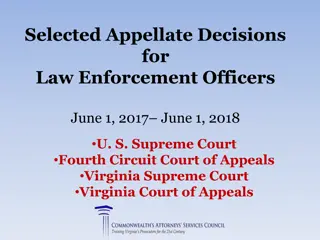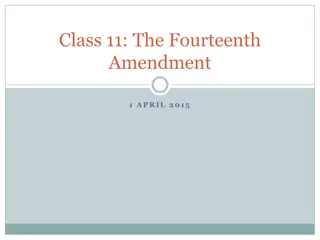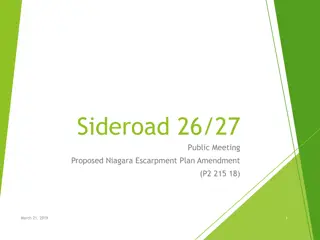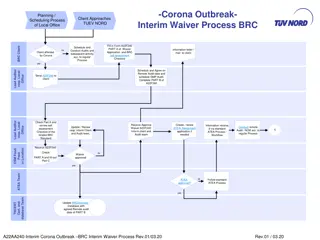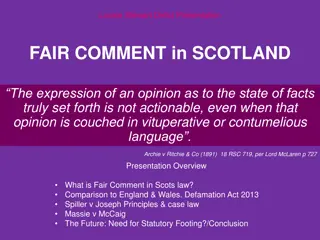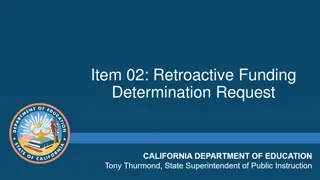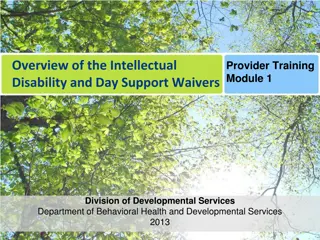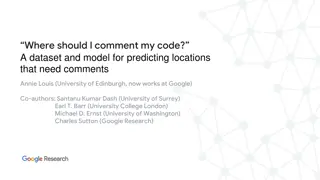Public Comment Period for DDDS Lifespan Waiver Amendment
The public comment period for the DDDS Lifespan Waiver Amendment runs from November 1, 2016, to December 19, 2016. Individuals can provide feedback via email, fax, or written comments. Public meetings will be held in various locations in Delaware during the week of November 28th, 2016, to discuss the proposed changes. The amendment aims to enhance services for families and individuals with intellectual and developmental disabilities through the Lifespan Waiver. Cost-effective strategies are in place to ensure the sustainability of services.
Download Presentation

Please find below an Image/Link to download the presentation.
The content on the website is provided AS IS for your information and personal use only. It may not be sold, licensed, or shared on other websites without obtaining consent from the author.If you encounter any issues during the download, it is possible that the publisher has removed the file from their server.
You are allowed to download the files provided on this website for personal or commercial use, subject to the condition that they are used lawfully. All files are the property of their respective owners.
The content on the website is provided AS IS for your information and personal use only. It may not be sold, licensed, or shared on other websites without obtaining consent from the author.
E N D
Presentation Transcript
Ineffabilities and Conventional Truth in Jn a nas rimitra s Buddhist Philosophy of Language Amy Donahue, Ph.D. Department of History & Philosophy Kennesaw State University Barbara Kruger, Untitled (1981)
What is philosophy? An intellectual ethnicity (V. Mudimbe)? One notion: a transcultural and transhistorical practice, propelled by competing imperatives: To critique contemporary practices, concepts, and norms, and . To engage and act in the world
Buddhas Philosophical Context (5th 4th centuries BCE) Widespread contestations of Vedic practices, concepts, and norms Creative syntheses of old & new ideas and values duty, cosmology, identity, social hierarchy, etc. (e.g., yajn a, karma, samsara, varn a) Early Upanis ads / beginnings of Veda nta Teachings of Maha vi ra, founder of Jainism
The Buddhas Middle Way Middle Path between: Acquiescence to conventional norms & conceptions Householder practices, concepts, and hierarchies (e.g., varn a) Escape from acting and living in the world Path of ascetic renunciation
How the Buddha Taught Used reductionist arguments (and non-Brahmanical language) to challenge (and mock) Vedic sacrifices & authority; critiqued both exoteric householder practices and esoteric forest pursuits. Associated householder and forest pursuits withtan ha (tr s n a , Sanskrit) problematic desire. Both paths thirst after, anticipate, pursue abstractions, things that are not present. Instead, advised mindful attention to phenomenal processes (5 interdependent heaps of momentary actions & reactions) that make abstract objects (like true selvesand the varn a-s?) seem stable and present i.e., advised cultivating habits of pacific and lucid thinking, speaking, and doing (The Noble 8-fold Path) in lieu of obeisance to Vedic norms and categories
Early Buddhist Elaborations (First 900 years after the Buddha) Abhidharma (3rd century BCE ) Reduction of seemingly enduring objects to discrete, elemental kinds of phenomena (dhamma-s), likely with a focus on meditative practice Sarva stiva da (2nd or 1st century BCE ) Asserted ontological reality of dhamma-s. Madhyamaka (approx. 2nd or 3rd century CE ) Na ga rjuna: argued against essentialism, reductionism, and other theses Argued for emptiness (s u nyata -- zero-ness ) attachment to theses is a form of tan ha . Yoga ca ra (4th or 5th century CE ) Vasubandhu: used cittama tra (consciousness-only) thesis to challenge conventional conceptions & to redirect attention to momentary phenomena.
Dignagas Theory of Language & Cognition Fifth century CE Buddhist, influenced by Yoga ca ra and Vasubandhu. Challenged Vedic authority by questioning how and what people can know through words (i.e., through the Vedas s ruti). Asserted distinction between cognition of: unique, momentary phenomena (svalaks an a-s) generic, enduring objects (sama nyalaks an a-s)
Dignagas Pramana (instrument of knowledge) Va da (theory) Through Sensation / Perception (Pratyaks a): Unitary, undivided cognition Direct, immediate grasp of momentary svalaks an a-s. Svalaks an a-s are vivid, momentary, particular, and real Through Words & Inference (Anuma na): Cognition is twofold, with a directly perceived svalaks an a serving as inferential basis or sign (paks a) for an inferred signified object (artha) Signified object is a sama nyalaks an a and is never present to thought Sama nyalaks an a-s are generic, persistent, universal, and unreal
Dignagas Pramanavada: Verbal Knowledge is Inferential Knowledge Sign (paks a) ---------------->Signified object (artha) smoke fire Svalaks an a ---------------->Sama nyalaks an a Momentary Unique Vivid Beyond Words Real fire fire Enduring Generic Dull Nothing But Words Conventionally real, at best Ultimate truth/reality Conventional truth/reality
Dignagas Arguments Against Knowledge of of Things Through Words Argument 1: We do not cognize objects through words Words, such as cow, signify indefinitely many particulars (e.g., brown cows, spotted cows, large cows, small cows .) If objects were known through words, many particulars would be present to thought Be we aren t aware of indefinitely many particulars when we comprehend words
Dignagas Arguments Against Knowledge of of Things Through Words Maybe instead of knowing objects through words, we know instantiated properties / universals e.g., When we hear cow we come to know a thing qualified by cow-ness; when we hear male, we come to know a thing qualified by male-ness; when we hear fabulous, we come to know a thing qualified by fabulousness, etc., etc. But this doesn t work either .
Dignagas Arguments Against Knowledge of of Objects Through Words Argument 2: We do not cognize instantiated properties / universals through words If we cognized instantiated properties through words, then properties would depend on their instantiations If properties depended on their instantiations, then analytic associations between words (e.g., pot and vessel ) would have no basis All conceptual associations would be contingent, like white and sweet
Dignagas Arguments Against Knowledge of of Objects Through Words Argument 3: We do not cognize instantiated properties / universals through words If we cognized instantiated properties through words, then objects would have to embody their predicates either figuratively or literally If objects literally embodied their predicates, then all objects would epitomize their universals. (e.g., every cow would be an exemplary cow) If objects figuratively embodied their predicates, then they would have to resemble their predicates either metaphorically or non-metaphorically
Dignagas Arguments Against Knowledge of of Objects Through Words Argument 3: We do not cognize instantiated properties / universals through words (cont.) When things metaphorically resemble other things, we are aware of differences between the thing and the property it metaphorically resembles E.g., we call leaders servants of the people, but don t really expect them to behave like servants But we don t cognize differences between things and properties. E.g., between the reality of a pot and reality per se But if things non-metaphorically resembled properties, then there would be as many properties as things. Instead of using general terms, we d use specific terms for each thing.
Exclusion Theory of Meaning What, then, do we know through words? (e.g., varn a, gender, conventional truth ) NOTHING Words work through exclusion of the other (anya- apoha); they work only if they present nothing to thought. Knowledge from words is conventional and inferential, pace text traditions which claim special, direct knowledge from the Vedas
Implicit Ineffabilities in Dignagas Exclusion Theory of (Verbal) Meaning Svalaks an a-s (directly sensed particulars) are beyond words, because objects of words, like of inference, are generic (sama nyalaks an a-s) Sama nyalaks an a-s (enduring objects) are beyond words, since they are never present to thought Hence, as Jn a nas rimitra later claims, words express nothing whatsoever
Dignaga Summary We know objects at best conventionally, through practices of exclusion Ultimately, all knowledge is immediate sensing of unique, momentary particulars Objects are anticipated fictions Digna ga, one might say, directs attention from the pursuit, grasping, thirsting after things (e.g., a tman, dharma)to phenomenal processes that constitute lived experience, including practices of exclusion (i.e., practices that the 8-fold path counteracts)
Madhyamaka Buddhist Criticisms of Digna ga s Prama n a Project Recall that, about 2 centuries earlier, Na ga rjuna had argued against essentialism, reductionism, and other theses contended that attachment to theses is a form of tan ha argued for emptiness (s u nyata -- zero-ness ) Digna ga s prama n a program struck contemporary Madhya ma ka Buddhists as another instance of Buddhist reductionism and thirsting after theses Candraki rti (7th century) seems to have critiqued Digna ga s prama n a theory directly.
Candrakirtis Criticisms of Dignagas Prama n a theory What Digna ga calls perception is nothing like what people in/of the world think of as perception What people in/of the world consider perception (e.g., seeing enduring objects, such as people, cows, and pots) would also have to operate through exclusion-of-the-other Digna ga uses svalaks an a in a weird way too, treating it as a noun of an adjective And what is gained by this new doctrine that a) expressible knowledge isn t truly knowledge, b) true knowledge is inexpressible, and c) only unique, momentary particulars are real?? Why replace views and practices of folk in/of the world with these (also imperfect & utterly impracticable) views and practices? We d be better off sticking to the views and practices of people in/of the world
Candrakirtis Praise for lokasam vr tisatya and lokavyavaha ra satya truth / existence samvr ti concealed, covered loka people, folk, the world vyavaha ra practices, agreements Lokasam vr tisatya: The (pseudo / benighted) truths and realities of folk in/of the world. (Frequently translated as conventional truth ) Lokavyavaha ra: The practices of folk in/of the world. (Frequently translated as conventional practice )
Jnanasrimitras Buddhist Philosophy of Language 11th century CE Buddhist philosopher; one of last in the prama n a tradition Influenced by Buddhist apoha philosophies of language *and* Candraki rti s and others appeals to conventional truth. The central thesis of his Monograph on Exclusion is that all things (dharma-s) are inexpressible He supports this universal ineffability thesis by arguing that exclusion is what is revealed by words and inferential reasons. Like his predecessors, he also accepts and builds on notions of conventional truth (lokasamvr tisatya). Specifically, he says that conventional truth can warrant conditionally adopted positions (vyavastha -s) (93). According to Parimal Patil, these conditionally adopted positions function as white lies. Are apoha and appeals to vyavastha -s merely clever, yet dubious rhetorical devices?
Jnanasrimitras Concept of Conditionally Adopted Positions Vyavastha -s are warranted either by conventional or ultimate truth Conventional truth consists in the understanding of ordinary people i.e., folk in/of the world and is the universally accepted basis for action and inaction [229.14]. By the standard of ultimate truth, i.e., what is really the case, vyavastha -s are always false. Yet a conditionally adopted position can be warranted by ultimate truth if, relative to what is really the case, it is somehow less benighted than another position (i.e., it leads to the cessation of the thirsts that propel an inquiry). Rather than a dichotomy between ultimate truth and conventional truth, we have ultimate truth, which is inexpressible and provides no apparent basis for practical action, and various orders of conventional truth, distinguished by their degrees of practical efficacy [231.03].
Jnanasrimitras Pramana-vada 4 apparently contrary theses about reference 4 apparently contrary theses about the place of apoha (exclusion) in meaning All are conditionally adopted positions Concept of vyavastha -s enables a distinct style of dialectical philosophizing [the Jn a nas rimitra c Method?]
Jnanasrimitra on Reference Four Contrary Vyavastha -s 1. Words primarily express external objects, rather than mental images 2. Words express objects as grounds for determination, rather than really expressing external objects. 3. Words express objects on the basis of an appearance, rather than really expressing objects as grounds for determination. 4. Words express nothing whatsoever, rather than really expressing objects on the basis of an appearance.
Exclusion in Jnanasrimitras Philosophy of Language How is exclusion an element of the reference of any conceptual awareness? 1. Exclusion is a property among properties. It is an element of awareness of objects. E.g., just as we comprehend the moon s brightness, we also comprehend the moon s exclusion from non-moons. (Who would deny this??) 2. In conceptual awareness, a single image appears and that image represents all the individuals intended by the concept; exclusion helps to determine which individuals those are. (Who would deny this??) vikalpa (image) svalaks an a -----------> determined object (artha) (excluding helps to determine) -----------> sa ma nyalaks an a
Exclusion in Jnanasrimitras Philosophy of Language 3. Exclusion not only necessary qualifies the determination of an object on the basis of an appearance, but is really the only way any object is determined vikalpa (image) -----------> (excluding is the only way to figure out) svalaks an a -----------> determined object (artha) sa ma nyalaks an a 4. The determined object and the exclusion that qualifies that determined object differ in name alone. No object is really expressed by words, since all we have are practices of exclusion that, when we judge well, end with the cessation of the thirst that propels the excluding. Further, it would be useless and/or impossible for words to express mental images. Hence, nothing at all is expressed by words.
Exclusion is the whole point of language use. Even in the sentence, This road goes to S rughna, this principle is easily satisfied. It is just this relative to roads other than the intended one; it is just to S rughna relative to undesired places other than S rughna; it just goes because it doesn t end in a forest path; and it is just a road in virtue of excluding caravans, messengers, and the like [206.04]. -- Jn a nas rimitra, Apohaprakaran am. McCrae and Patil, trans.
Conventional Truth in Jnanasrimitras Philosophy of Language Contemporary scholars sometimes associate lokasamvr tisatya with pragmatic theories of truth (e.g., Quine s conceptual schemes or Rorty s cultural relativism) But Jn a nas rimitra s use of conditionally adopted positions suggests that in his philosophy of language, conventional truths are not socially widespread, hegemonic understandings -- e.g., cultural beliefs such as modern Americans believe nature establishes a binary gender system ancient Indians believed that humanity is naturally divided into four varna-s Rather, they are benighted understandings that people in/of the world whom one converses with happen to hold because of their specific karmic pasts and upbringings (220.21). E.g., a culturally unrepresentative belief such as aliens abduct people off of highways could be conventionally true, depending on the context of dialogue. Conventional truths are normative and should not be disturbed, unless another position is relatively less benighted With Jn a nas rimitra s notion of conditionally adopted positions, we appear to have a method of critiquing prevailing conceptions without prioritizing new arcane dogmas and theories (i.e., withdrawing from the world).
Assessment On what grounds are some conditionally adopted positions more efficacious than others, given that words express nothing whatsoever? Application to: Varn a Gender Conventional Truth If we thought that things corresponded to these categories, we d be inclined to think that they were already established and unproblematically known. Consequently, we d ignore the reiterative practices of exclusion that contingently constitute them. If we thought that things corresponded to these categories, we d be inclined to pathologize individuals who failed to adhere to them (i.e., we d unwittingly & perhaps violently construct these ultimately imaginary, conventionally real categories through exclusion of the other). Conversely, perhaps, if we attend to their emptiness, we might be more likely to question the appropriateness of the practices of exclusion that problematically determine some categories (e.g., gender & varna, but not the road to S rughna). We may therefore prioritize the Noble Eightfold Path over mindless & futile exclusions of others needed to reify transcendent, ultimately unreal categories and concepts.
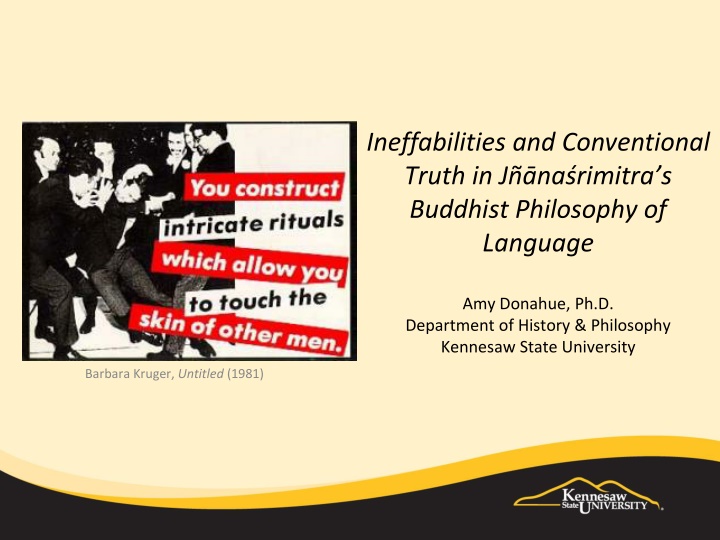

![RE: ELECTORAL MATTERS AMENDMENT BILL [ B42-2023]](/thumb/18837/re-electoral-matters-amendment-bill-b42-2023.jpg)





